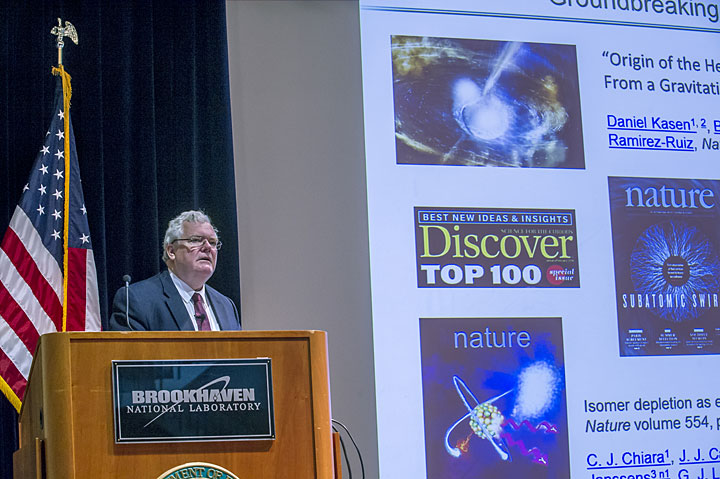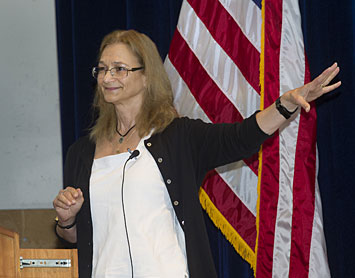2018 RHIC & AGS Annual Users' Meeting: 'Illuminating the QCD Landscape'
Talks highlight successes and exciting times ahead in the study of quantum chromodynamics (QCD)—the principles governing the interactions of the most fundamental building blocks of matter.
July 3, 2018
Scientists and others with a stake in the research taking place at the Relativistic Heavy Ion Collider (RHIC) and Alternating Gradient Synchrotron (AGS) gathered at the U.S. Department of Energy’s (DOE) Brookhaven National Laboratory June 12-15, for their annual users’ meeting. In a series of workshops and plenary sessions, attendees from across the nation and around the world had a chance to catch up on the latest research results across all aspects of the RHIC-AGS scientific program and engage in conversations about the exciting plans that lie ahead.
“These user meetings are really important to us,” said Brookhaven Lab Director Doon Gibbs as he welcomed attendees at a plenary session on June 14. “It gives us a chance to tell you about what’s new at Brookhaven, what we’re thinking about as next steps at the Lab, and to get your feedback. At the same time, it lets us hear from you, about your latest results—and for you to tell us what is and isn’t working.”
From a science standpoint, one central theme of the meeting was that RHIC, a DOE Office of Science user facility for nuclear physics research, continues to be working extremely well—in many cases, beyond expectations.
“You know as well as I do how well RHIC is doing; it just continues to be fantastic,” said Timothy Hallman, Director of the Office of Nuclear Physics (NP) within DOE’s Office of Science, the primary funding agency for RHIC operations and research. Hallman noted that RHIC is widely recognized as “a facility that’s unparalleled in the world for heavy ion and spin research.”
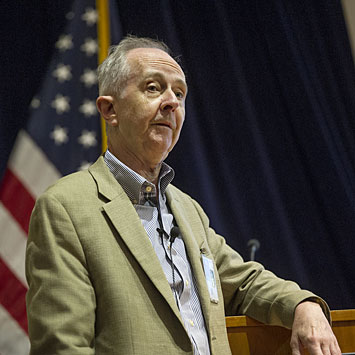 enlarge
enlarge
Berndt Mueller, Brookhaven Lab's Associate Laboratory Director for Nuclear & Particle Physics
Berndt Mueller, Brookhaven’s Associate Laboratory Director for Nuclear and Particle Physics, echoed this sentiment, stating, “RHIC is and remains a unique discovery facility.” His talk emphasized the wide range of science enabled by continuous enhancements to collider and detector capabilities, as well as plans for the future.
Results from the STAR and PHENIX collaborations, named for RHIC’s two large original experiments, figured prominently in many of the talks. While STAR continues to take new data, PHENIX is preparing for a major upgrade known as sPHENIX, but both collaborations have archives of past data to analyze.
Among the highlights were:
- The latest data from the beam energy scan—an exploration of how fundamental quarks and gluons (the particles that make up protons and neutrons) exist under various conditions of temperature and pressure, created by colliding ions at different energies.
- New measurements from collisions of polarized proton beams that are revealing how quarks and gluons contribute to proton spin, a property that makes MRI scanning possible but is still not fully understood.
- How tracking jets of particles emitted from the substance created in RHIC’s most energetic collisions, known as quark-gluon plasma (QGP), can reveal details about the properties of this unique substance.
- Characteristics of tiny droplets of quark-gluon plasma created in collisions of small particles with larger nuclei.
- Details of how different types of particles containing heavy quarks interact with the QGP.
- New measurements of the vorticity of RHIC’s quark-gluon plasma, which is the most “vortical,” or swirly, fluid ever observed.
- And theoretical models, predictions, and analyses related to these experimental results.
RHIC Run 18 a huge success
Exploring the details of the QGP’s vorticity and its implications was a central goal of RHIC Run 18, which was just wrapping up as the users' meeting took place. That run was unique in a number of ways, including that it was the first time RHIC produced collisions of pairs of “isobars,” ions with the same atomic mass but different numbers of positively charged protons. Comparing collisions of these two isobar species (ruthenium-96 and zirconium-96) gives scientists a way to explore how the strength of the magnetic field created by the swirling positive charges affects the vorticity and separation of charged particles while holding all other collision conditions constant. Scientists hope to use the data to explore a physics phenomenon known as the chiral magnetic effect.
Producing the isobar collisions presented several challenges. First, acquiring the ruthenium-96 and zirconium-96—neither of which exists naturally in sufficient quantities—required coordination with partners at Japan’s RIKEN laboratory, DOE’s Oak Ridge National Laboratory, and the DOE Isotope Program. In addition, physicists in the STAR collaboration wanted to switch between zirconium and ruthenium collisions regularly to control for any systematic effects that might occur if the two types of collisions were conducted sequentially, weeks apart.
“There are more than a million parameters in our control system that we have to take care of [when setting up collisions],” said Run Coordinator Greg Marr of Brookhaven’s Collider-Accelerator Department. Not all those things need to get changed between collisions of the different ion species, he noted, but even to keep track of them all would be “too complicated and too time consuming—a little bit like herding cats.”
Instead, by narrowing down to a few thousand parameters, the C-AD team was able to develop a system for making the rapid switches between the isobars—and even gold-gold collisions at two different collision energies to accomplish additional research objectives during the run.
“This was first time RHIC had three different species running in the same 24 hours!” Marr said.
STAR physicists had been hoping for about a billion collisions of each isobar species, but received three times that by run’s end—an accomplishment worthy of a round of applause for the C-AD scientists, technicians, and engineers who made it happen, Mueller said. “The statistical precision of the data that we get in the comparison between the two isobar systems will exceed anything that we hoped for,” he noted. “This will be fantastic data.”
Zhangbu Xu, co-spokesperson for the STAR collaboration, added his appreciation in a comment after Marr’s talk. “I want to thank C-AD for this effort and these fantastic operations,” he said.
The run was also successful in using the gold-gold collisions to commission equipment for a low-energy electron-cooling scheme, and in producing collisions of gold with a fixed target within the STAR detector to collect data at low energy for the beam energy scan.
The future at Brookhaven and RHIC
The plenary talks also included discussions about future research plans at RHIC for next year’s run and beyond, as well as plans to make the Laboratory more welcoming to researchers.
“We understand the challenges involved in traveling—the effort—and we appreciate it,” said Laboratory Director Gibbs. He mentioned progress on several fronts that should make future visits more convenient. These included Congressional support for a new Science and User Support Center, the anchor building for Discovery Park, a public-private partnership development designed to make the Lab more accessible with more amenities for users and others, and New York State’s plan to build a Long Island Rail Road station at the edge of the Lab property.
“Both of those plans are moving forward and will help us move the Laboratory to another level both scientifically and in the way we connect with people. It’s going to be easier for you all to get here and work with us. But it also is going to open the interface to the larger world, especially the local community but also more broadly,” Gibbs said.
For the future of RHIC science, Mueller described plans for the Beam Energy Scan II in Runs 19, 20 and 21, using collisions at different energies, including some in the lowest energy ranges produced by fixed target collisions. Several detector upgrades already installed or near completion at STAR will aid in the search for a critical point in the QCD phase diagram.
Mueller also noted successful tests of key components of the sPHENIX upgrade—including the 1.5 Tesla superconducting magnet that will be central to using its time projection chamber, and electromagnetic and hadronic calorimeters. He also noted that sPHENIX just completed a key project review.
The notional schedule has sPHENIX construction beginning in 2019, in time for installation during 2022, with the newly configured detector ready to take data starting in 2023. sPHENIX will track jets and particles containing heavy quarks with different masses to discern how the properties of quark-gluon plasma change from the microscopic scale of quarks and gluons to the more macroscopic scale of the freely flowing perfect liquid.
The Path to an Electron Ion Collider
On a longer timescale the Brookhaven team proposes to convert RHIC into an Electron Ion Collider (EIC).
An EIC would image nucleons (the protons and neutrons that make up atomic nuclei) with a precision that compares with how we can image atoms and molecules so scientists can understand, on a variety of length scales, how the nucleons are constructed from their fundamental quark and gluon constituents. It would also explore the most interior components of the protons and nuclei—the “glue fields,” where gluon densities become very large—to reveal what happens when gluons saturate to create a new form of matter that theorists have postulated but which has yet to be experimentally isolated.
“So there is both plenty of precision physics and discovery potential at an EIC,” Mueller said.
At the time of the RHIC & AGS Annual Users’ Meeting, physicists were eagerly awaiting the release of a report from the National Academy of Sciences, which conducted an extensive review of the science case for building a proposed EIC.
DOE’s NP Director Timothy Hallman noted that the report would be made public very soon. “That sets the stage for the next step when we establish mission need for this very important facility for the future.” The DOE has not yet identified a location for the proposed EIC.
Gibbs and Mueller both noted that they expect the NAS report to be positive, and that the nuclear physics community is looking forward to taking the next steps after that.
“There are very exciting times ahead, both near-term, midterm, and possibly long-term,” Mueller said. “But in order to realize this program, we need the support of the whole nation, not just our community. We need to do effective outreach and convey the excitement of the program that we believe in.”
Budget outlook
As several speakers noted, at present, the budget outlook is quite optimistic, but there is always uncertainty about how things will go.
In fiscal year (FY) 2018, for example, NP was expecting a somewhat lower allotment of funding than in the previous year. But then, “in what you might call a New York minute,” funding significantly above the FY17 number was appropriated, enabling increased running at RHIC and the other NP-supported facilities, NP Director Timothy Hallman said. “The outlook for FY19, based on House and Senate marks, provides significant support for the very important work that you do,” he added.
“I think the message you can take away is that things look pretty positive at the moment, but there is a great deal of uncertainty in how things should go. It’s very important to continue to carry the message to anyone who will listen about the importance of the work that nuclear science does and the research that we do and why it’s valuable to the nation,” he emphasized.
“Our job is to stay focused and to continue to deliver the things that make this [research] valuable for the country: new knowledge and technology, R&D integration, innovative applications, a well-trained nuclear-capable workforce for a variety of important national needs,” Hallman said.
He pointed out that almost half the people who earn doctoral degrees in nuclear physics go on to apply their knowledge beyond the national laboratories and academia, citing examples such as the founder of a cloud computing company, founder of a venture capital firm, a director of radiological development in a global healthcare company, vice president of engineering at a software application development company, and more.
“So the people that are being trained in nuclear science by the work that we do go all through our society and do a variety of very important things,” he said.
Hallman also highlighted a direct impact of the nuclear physics program on the production of important medical isotopes, including alpha-emitting isotopes that show great promise in the treatment of cancer. Brookhaven Lab, along with Los Alamos and Oak Ridge national laboratories, plays a direct role in making sufficient quantities of actinium-225 for clinical trials and therapeutic application. “So we are enabling the saving of lives with research that’s being done in the DOE Isotope Program,” Hallman said.
Allena Opper, Program Director at the National Science Foundation, also emphasized the uncertainty in the budget picture during her remarks, having experienced the same reversal from “pretty scary” proposed cuts for FY18 to a budget that turned out to be very good compared with FY17. The president’s budget request for FY19 brings funding back to FY17 levels, which is not as bad as it would have been without Congress raising a cap on funding, she noted.
“If we are funded at this level, there will be a small increase to the research and related activities throughout NSF,” Opper said. But within the Physics Division there would be a 5.2 percent cut compared to FY17, and because the facility operations would be held to the FY17 levels, there would be an 11 percent cut to the research programs. A chunk of NSF’s FY19 budget would support NSF’s “10 Big Ideas,” including four that Opper noted are relevant for nuclear physics: harnessing the data revolution, windows on the universe (which includes nuclear astrophysics), the next quantum revolution, and mid-scale research infrastructure projects that bridge the gap between small and large-scale projects. Opper also noted that the Physics Division has its own smaller mid-scale budget line for projects budgeted at $4-13 million.
“This Physics mid-scale funding line has been very productive and it’s an opportunity that the nuclear physics community can take advantage of,” she said.
The deadline for investigator-initiated research projects within the Physics Division is December 5. There are also opportunities for supplemental funding to NSF awardees in the Alliances for Graduate Education and the Professoriate (AGEP) program, which aims to increase the number of historically underrepresented minority faculty in science, technology, engineering, and mathematics (STEM) disciplines.
Opper also noted that NSF is trying to put together a mentoring program to help young researchers learn how to write successful proposals. Mentors commit to reviewing one version of a proposal and providing feedback.
For questions about any of this, Opper said, “Don’t hesitate to contact us. We like hearing from you and we like talking about your science ideas and trying to help you understand the details of our solicitations and funding opportunities.”
Respect, diversity, careers
Respect for others was a recurring theme throughout the meeting, with the Lab’s anti-harassment policy posted prominently during sessions and on the meeting website. During Hallman's presentation, he noted that DOE's Office of Science—which is also working to foster an environment free from discrimination and centered on professionalism—is presenting a similar code of conduct for participants during its meetings, too.
The afternoon of June 13 was devoted to talks on diversity and career development.
The first session included talks about recruiting and retaining students from underrepresented groups in physics, diversity at Brookhaven Lab specifically and in the field of physics in general.
Brookhaven's Inclusion & Diversity Manager Shirley Kendall gave a presentation on the Lab's plan to foster an environment in which everyone at the Laboratory—representing diversity in all its forms—values and respects one another while working together. Some of major initiatives Kendall described included the Lab's efforts to recruit, develop, and retain a diverse, talented workforce; prevent discrimination and profiling; and educational outreach and community involvement.
In the second session that afternoon, attendees heard personal accounts from two individuals who have pursued differing career paths: Dave Winter who made his way from physics to the global bond marketplace, and Megan Connors, who now participates in the sPHENIX collaboration as a professor at Georgia State University and gave a talk titled "How Did I Get Here." They were then joined by a diverse group of attendees for a panel discussion on career tips.
And the awards go to…
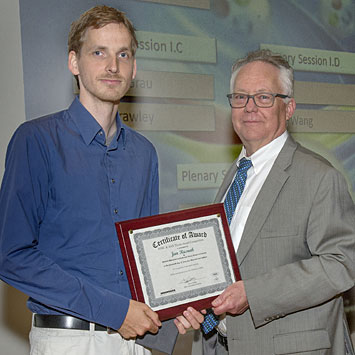 enlarge
enlarge
Brookhaven Lab Director Doon Gibbs (right) recognizing annual thesis award competition honoree Jan Rusnak of Czech Technical University
As the first of two days of plenary sessions drew to a close, Lab Director Doon Gibbs recognized five recent Ph.D. graduates for their outstanding research conducted at RHIC, the AGS, and associated accelerator facilities, including the NASA Space Radiation Laboratory. The winners in the annual thesis award competition were:
- Jan Rusnak of Czech Technical University in the Czech Republic. Rusnak's thesis, titled "Jet Reconstruction in Au+Au Collisions at RHIC," was chosen for his measuring charged jet production in gold-gold collisions.
- Ting Lin of Texas A&M University. Ting's thesis, titled, "Longitudinal Double-spin Asymmetries for Di-Jet Production at Intermediate Pseudorapidity in Polarized P+P Collisions at √s= 200 GEV," was selected for research probing gluon spin distribution.
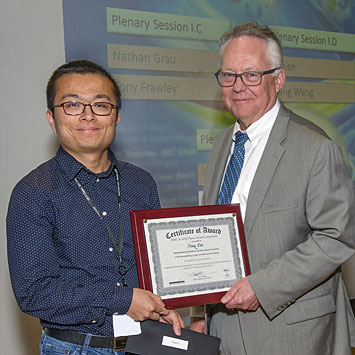 enlarge
enlarge
Annual thesis award competition honoree Ting Lin of Texas A&M University (left) with Brookhaven Lab Director Doon Gibbs
Typically, two students receive honorable mention in the thesis award competition. This year, however, the committee of judges deemed three worthy of the recognition, based on the criteria of clarity, presentation, originality, and physics content. They were:
- Ivan Gadjev of University of California at Los Angeles,
- Qiao Xu of Vanderbilt University
- Pavlina Todorova of the University of Texas Southwestern Medical Center
Pavlina Todorova won top honors during the users’ meeting poster session. Joining her as first runner up in the poster session was Amani Kraishan from Temple University.
The RHIC-AGS Users’ Executive Committee (UEC) also presented its first-ever Merit Awards to scientists who earned a Ph.D. within 10 years and conducted outstanding theoretical or experimental research at RHIC, the AGS, NASA Space Radiation Laboratory (NSRL), Tandem Van de Graaff, Brookhaven Linac Isotope Producer, and Accelerator Test Facility (ATF). In addition, the UEC recognized outstanding publications by students whose work was done before receiving their Ph.Ds. The Merit Award honorees are Jonah Bernhard, Cesar Luiz da Silva, James Drachenberg, Rosalin Goss, Takeshi Kanesue, Minjung Kim, Xiaofeng Luo, Takafumi Niida, Matthew Sievert, Isaac Upsal, and Haiwang Yu.
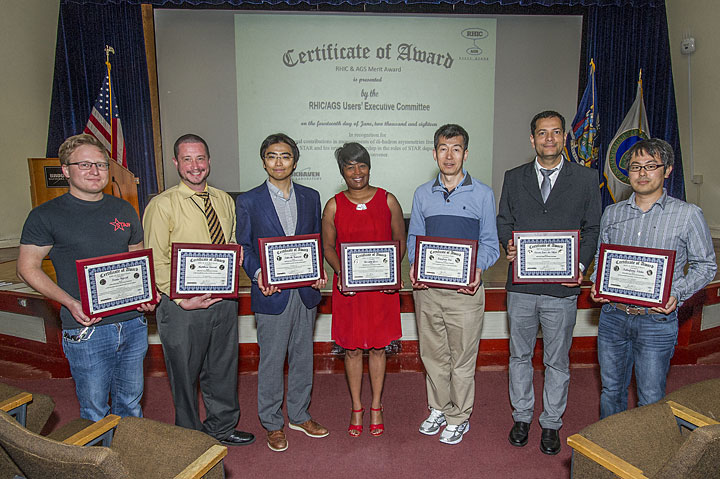 enlarge
enlarge
Scientists at the users' meeting who received the RHIC-AGS Users' Executive Committee's first ever Merit Awards: (from left) Isaac Upsal, Matthew Sievert, Takeshi Kanesue, Rosalin Goss, Xiaofeng Luo, Cesar Luiz da Silva, and Takafumi Niida
Election results are in
Before the meeting concluded on June 15, RHIC-AGS Users' Executive Committee (UEC) Chair Jim Thomas of Lawrence Berkeley National Laboratory announced UEC election results. The UEC represents scientists whose research makes use of five user facilities at Brookhaven: RHIC, the AGS, Tandem, ATF, and NSRL. The group provides an organized channel for discussions between these scientists and the Lab's administration. The UEC is also primarily responsible for organizing the annual users' meeting, with support from Brookhaven's Guest, User & Visitor Center and others across the Lab site.
Sevil Salur of Rutgers University was elected incoming chair, Thomas announced. Other newly elected members are:
- Jasmine Brewer, Massachusetts Institute of Technology (student-postdoc member)
- Oleg Eyser, Brookhaven National Laboratory
- Frank Geurts, Rice University
- Xuan Li, Los Alamos National Laboratory
- Sooraj Radhakrishnan, Lawrence Berkeley National Laboratory (student-postdoc member)
- David Tlusty, Rice University (student-postdoc member)
UEC members whose terms ended are Daniel Brandenburg, Gabor David, Alexander Jentsch, Li Yi, Peter Petreczky, Mathew Posik, Lijuan Ruan, and Bernd Surrow.
Thomas also proposed a change to UEC bylaws after noting benefits of the committee's current make-up with three students or postdocs serving—one more than allowed by the bylaws. On the UEC's behalf, he recommended changing the committee's bylaws to increase the number of members from 18 to 19 to continue including a third student or postdoc as a permanent role in the organizational structure. The amendment was passed by acclamation.
Joe Gettler contributed content to this story.
# # #
Brookhaven National Laboratory is supported by the Office of Science of the U.S. Department of Energy. The Office of Science is the single largest supporter of basic research in the physical sciences in the United States, and is working to address some of the most pressing challenges of our time. For more information, please visit science.energy.gov.
Follow @BrookhavenLab on Twitter or find us on Facebook.
2018-12958 | INT/EXT | Newsroom





